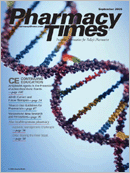Publication
Article
Pharmacy Times
Asplenia Poses Management Challenges
Author(s):
Patients with asplenia or functional hyposplenism (complete or partial lack of splenic function) are at lifelong risk for serious infection. Asplenia and splenic hypoplasia can be congenital or acquired. They may be the consequence of surgical removal after blunt trauma (splenectomy) or splenic infarction (autosplenectomy) secondary to hemoglobinopathy such as from chronic immune thrombocytopenic purpura (ITP). When congenital splenic anomalies occur, abnormalities in other organ systems, especially the heart, often are common.
Spleen Function
In animals, the spleen is a reservoir for red blood cells and serves as an autotransfusion device in times of need. The case is not the same in humans. Clinicians formerly believed that the spleen had no purpose.1 Experts now know, however, that it produces antibodies.2 Splenic macrophages also engulf and digest microorganisms and cellular debris from the circulatory system.3,4 Without these functions, asplenic patients, especially infants, are at significant risk for life-threatening infection and fulminant sepsis. Most serious infections in asplenic persons are due to encapsulated bacteria, Streptococcus pneumoniae, Haemophilus influenzae, and Neisseria meningitidis.2-5 Table 1 lists other threatening pathogens.2-4,6,7
The risk for fulminant infection is approximately 1 per 500 person-years of observation, but, cumulatively, one third of asplenic patients are hospitalized for severe infection over 10 years.2,3 Children lack specific antibodies against encapsulated organisms, increasing risk.8 Mortality in children with splenectomy pursuant to trauma is 50-fold greater, compared with that in healthy children. In children with sickle cell disease, it is 350-fold greater. Risk also increases in asplenic or hyposplenic patients who have compromised cellular immunity, are receiving chemotherapy or radiation therapy, or have had marrow transplantation.9,10
Serious infection is most likely to occur within 2 years of spleen loss. The increased risk, however, is lifelong. Some patients have experienced serious infections decades after splenectomy.2-4
Overwhelming postsplenectomy infection (OPSI) is the gravest threat. This stealthy infection has a short, nonspecific, influenza-like prodrome. Profuse bacteremia (usually with encapsulated organisms) follows rapidly, as does septic shock with disseminated intravascular coagulation.2-4 Up to 70% of patients die, often within 48 hours, despite aggressive treatment.2,4,6 Educating patients to seek medical attention immediately reduces mortality to about 10%.10
Most patients will remember and report having had a splenectomy. In decades past, however, surgeons often removed the spleen incidental to hiatal hernia surgery or partial gastric resection, and they may not have told patients.4 Table 2 lists conditions associated with hyposplenia.
Today, surgeons are apt to retain some splenic tissue when executing splenectomy,13 or to autotransplant splenic tissue into the patient's mesentery.2,14 This procedure provides unpredictable protection, so patients should be managed like asplenic patients.2-4
Immunization
Although asplenic patients' antibody response may be blunted, vaccination does confer protection. Table 3 summarizes the 5 recommended vaccinations. Note that, in immunocompetent recipients, pneumococcal vaccine fails to protect 20% to 30% of patients because it may not elicit a response and does not cover all serotypes.15
Pharmacists, especially those who can immunize, should ask about splenectomy in comprehensive medication reviews. Vaccines ideally are given at least 2 weeks before elective splenectomy.18 If it is impossible, they should be given as soon as possible after discharge from splenectomy or when hyposplenic conditions are identified. Pregnant or febrile patients should wait to be immunized. ITP patients may experience a transient relapse following vaccination.19 All of these immunizations can be given concurrently, using different syringes and injection sites.
Antibiotics for Prophylaxis and Treatment
No firm guidelines exist to direct prophylactic antibiotic use or to document its effectiveness.20 At a minimum, asplenic or hyposplenic children are given prophylaxis for 2 years after splenectomy,3,21 and they may continue for 5 years or longer.9,10 Due to bacterial resistance concerns and poor patient adherence, clinicians do not usually prescribe ongoing prophylaxis, but they provide a supply of standby antibiotics for adults to start as soon as they suspect infection.2,4,22 After starting antibiotics, patients must seek immediate medical help.
Broad-spectrum amoxicillin/clavulanic acid, trimethoprim/sulfamethoxazole, and cefuroxime have replaced penicillin and amoxicillin as drugs of choice.4,9,10 Because amoxicillin/clavulanic acid lacks activity against many penicillin-resistant pneumococci, and multidrug-resistant pneumococci also may be resistant to trimethoprim/sulfamethoxazole,9,22,23 cefotaxime and ceftriaxone are used empirically in patients suspected to have contracted penicillin-resistant pneumococcal strains.4,9
Should OPSI be suspected, swift, aggressive response should include hematologic/electrolyte/creatinine/glucose laboratory tests, then empiric antibiotic therapy, and radiologic studies, including a chest radiograph.2,4,6 Peripheral blood specimens should be examined for bacteria.6 Empiric use of a third-generation cephalosporin with or without vancomycin while awaiting culture results is imperative.4,9,24
Education
Up to 50% of asplenic patients are unaware of their increased risk for serious infection and are oblivious to necessary health precautions.25,26 They should wear a MedicAlert bracelet or necklace, carry a wallet card, and inform health care professionals, including dentists, of their asplenia or hyposplenia.4,26,27 Patients must know that acute febrile illness, especially if accompanied by rigors or systemic symptoms, may signal OPSI and its imminent threat.2,3 Clinicians must stress that H influenzae type b and pneumococcal and meningococcal bacteria often spread in day care centers, college dormitories, military barracks, and crowded facilities. International travel increases exposure to intraerythrocytic parasites such as Babesia microti and Plasmodium falciparum, and patients need to know about this hazard. Even minor animal bites require adequate antibiotic coverage.9,10
Final Thought
Antibiotic-resistant pneumococci are a growing concern, and nowhere is the concern greater than among asplenic and hyposplenic patients.5,9,15 As noted above, vaccines can fail, so patients must follow other preventive recommendations and avoid developing a false sense of security.2,4,6,24,25
Ms. Wick is a senior clinical research pharmacist at the National Cancer Institute, National Institutes of Health. The views expressed are those of the author and not those of any government agency.
For a list of references, send a stamped, self-addressed envelope to: References Department, Attn. A. Rybovic, Pharmacy Times, Ascend Media Healthcare, 103 College Road East, Princeton, NJ 08540; or send an e-mail request to: [email protected]

Newsletter
Stay informed on drug updates, treatment guidelines, and pharmacy practice trends—subscribe to Pharmacy Times for weekly clinical insights.






